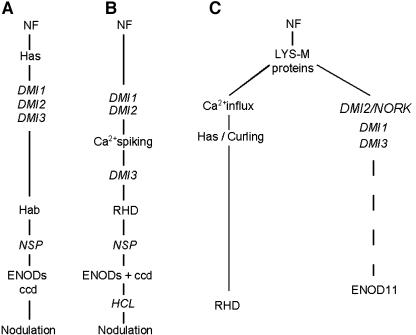Figure 11.
Putative NF-Induced Signal Transduction Pathways.
(A) Pathway proposed by Catoira et al. (2000).
(B) Pathway proposed by Wais et al. (2000). The difference between these two pathways is the positioning of Ca2+ spiking between DMI1-DMI2 and DMI3, and the combination of Has and root hair branching into RHD.
(C) New pathway, in which our results are integrated into the already published results. From our results, we can conclude that DMI2/NORK, DMI1, DMI3, and its downstream ProMtENOD11:GUS expression are not required for the early NF-induced morphological responses. Therefore, we propose that very soon after NF perception via LysM proteins and before DMI2/NORK, DMI1, and DMI3, the pathway forms a split. One part, including the rapid NF-induced Ca2+ influx, branches off to root hair reorientation/Has and RHD, and the other part via DMI2/NORK to ProMtENOD11:GUS expression. Because we only used ProMtENOD11:GUS as a NF reporter gene, we can only make a statement about this gene, and we do not want to exclude the possibility that in DMI2/NORK mutants other NF-induced genes are expressed.

